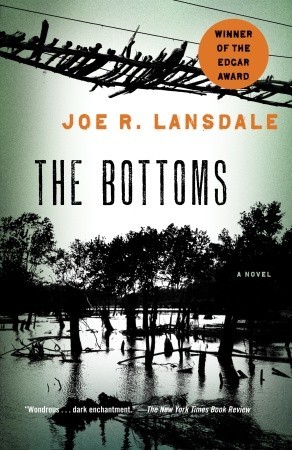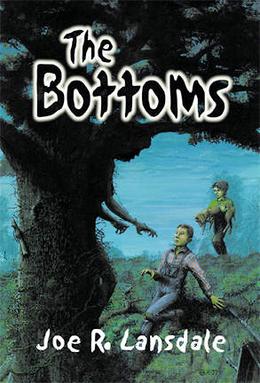Lansdale, Joe R., The Bottoms, NY: Mysterious Press, 2000.
The Bottoms at Goodreads
The Bottoms at ISFdb
Rating: 7.5/10
Eleven year-old Harry Crane and his little sister Thomasina "Tom" stumble upon the mutilated corpse of a black woman along the Sabine River in East Texas, 1933. The boy's farmer father, Jacob Crane, acts as the community's lawman, and through the boy's perspective we are brought into the investigation of brutal slayings amid a racially charged place and time.
Though I picked out the guilty party relatively early on, along with piecing together the mystery of the folkloric Goat Man, I nonetheless enjoyed the book tremendously. Lansdale's novel is elevated from basic mystery by its historical subject matter and, for the most part, the presentation of that subject matter.
There is a vividness to this novel that is important to its period setting, as the sights and scents of place and time come across clear and distinct. At no point did I feel that scenes had been inserted in order to deliver "local colour," as the plot was interwoven with each locale and character that steps onto the page. Nor did the novel feel at any time to be overlong or winded, so that even if Lansdale did include some pages for the sake of backdrop, he succeeded in weaving them into the overarching story-line. Perhaps because the plot is so tightly interwoven with each of the book's individual elements, much else can be forgiven. Despite this I would like to mention two points for thought.
While I enjoyed reading the characters of the novel, they are depicted with little ambiguity. It is suspect that any white person of 1933 would be so clearly one-sided in their estimation of persons of colour, since character is a product of its time, place and culture. I will stress that this issue does not detract from the novel nor did it from my reading the novel; the story precedes its presentation, and the plot is so tight that there is no need to complicate it with additional details. Regardless, those characters that are racist are full-fledged racists, which is believable, whereas those who are not racist are entirely without prejudice, which can be a little challenging. The only middle ground is offered by a minor character (when I locate my copy I will include his name here). A surprisingly sensitive portrait is given to this character whose function in the plot is clear and precise. He is trusted (practically forced) to watch over a black man who is brought in early as a suspect, and though, dim-witted as he is, he does try to do a capable job despite his obvious prejudices, which are enhanced by the fact that his daughter had relations with a man of colour, something if known publicly would be a death-call to the family. These details are not integrated into the plot and no resolution is offered, which is wise; but this detail complicates the hiding of the black man and, though the man entrusted with hiding him appears up front to be a pure racist, there are some touches that imply another side to his outlook on the situation, which I won't discuss here as it would reveal an important turn in the plot. In short, the bulk of the characters are defined with strict boundaries, as though the author were pointing at each one, saying "This one is good, we like her," or "This is a bad dude, we don't like him at all."
The other point I'd like to pause on is the representation of memory and voice. Without dalliance the reader is expected to accept that a dying man in his eighties is able to reconstruct, with an acute grasp of detail, events that occurred seven decades earlier. Collins recalls the minutest of details from conversation to observations, and has the added imaginative touch to describe his surroundings with the most visual of similes, such as the moon coming through the clouds as though it were awakening and peeking out from underneath sheets. Memory is inherently inaccurate and unreliable, and if we are to apply this reality to the narrative, we would be struggling with the idea that Crane is sharing an interpretation of events rather than the facts as he believes them to be. However, if we simply accept him at face value as a trusted narrator, we can immerse ourselves into the story.
The Bottoms received the 2001 Edgar Award for novel of the year (2000). The book is is currently in pre-production for a theatrical release that was originally slated for 2017. The man attached to directing the film was the recently deceased Bill Paxton, from a screenplay by Brent Hanley, who also scripted Bill Paxton's full-length directorial debut, the enormously entertaining Frailty. Sadly we will not see the results of a second collaboration between these two, though likely the project will continue at some point with another director attached.
On a completely irrelevant side-note: I read this novel about a month or so before posting this article and could not recall Harry's family name. Checking on Goodreads I saw immediately it was Collins, so inserted that into the appropriate spots. However, it did not right with me, and taking up my copy I saw that it is actually Crane. Beware of taking data from the internet without checking a more appropriate source, such as the book itself (or perhaps this very article).
For this week's Friday's Forgotten Books, please visit Patti Abbott's blog.
The Bottoms at Goodreads
The Bottoms at ISFdb
Rating: 7.5/10
 |
| Vintage Books (2010) |
Though I picked out the guilty party relatively early on, along with piecing together the mystery of the folkloric Goat Man, I nonetheless enjoyed the book tremendously. Lansdale's novel is elevated from basic mystery by its historical subject matter and, for the most part, the presentation of that subject matter.
There is a vividness to this novel that is important to its period setting, as the sights and scents of place and time come across clear and distinct. At no point did I feel that scenes had been inserted in order to deliver "local colour," as the plot was interwoven with each locale and character that steps onto the page. Nor did the novel feel at any time to be overlong or winded, so that even if Lansdale did include some pages for the sake of backdrop, he succeeded in weaving them into the overarching story-line. Perhaps because the plot is so tightly interwoven with each of the book's individual elements, much else can be forgiven. Despite this I would like to mention two points for thought.
While I enjoyed reading the characters of the novel, they are depicted with little ambiguity. It is suspect that any white person of 1933 would be so clearly one-sided in their estimation of persons of colour, since character is a product of its time, place and culture. I will stress that this issue does not detract from the novel nor did it from my reading the novel; the story precedes its presentation, and the plot is so tight that there is no need to complicate it with additional details. Regardless, those characters that are racist are full-fledged racists, which is believable, whereas those who are not racist are entirely without prejudice, which can be a little challenging. The only middle ground is offered by a minor character (when I locate my copy I will include his name here). A surprisingly sensitive portrait is given to this character whose function in the plot is clear and precise. He is trusted (practically forced) to watch over a black man who is brought in early as a suspect, and though, dim-witted as he is, he does try to do a capable job despite his obvious prejudices, which are enhanced by the fact that his daughter had relations with a man of colour, something if known publicly would be a death-call to the family. These details are not integrated into the plot and no resolution is offered, which is wise; but this detail complicates the hiding of the black man and, though the man entrusted with hiding him appears up front to be a pure racist, there are some touches that imply another side to his outlook on the situation, which I won't discuss here as it would reveal an important turn in the plot. In short, the bulk of the characters are defined with strict boundaries, as though the author were pointing at each one, saying "This one is good, we like her," or "This is a bad dude, we don't like him at all."
The other point I'd like to pause on is the representation of memory and voice. Without dalliance the reader is expected to accept that a dying man in his eighties is able to reconstruct, with an acute grasp of detail, events that occurred seven decades earlier. Collins recalls the minutest of details from conversation to observations, and has the added imaginative touch to describe his surroundings with the most visual of similes, such as the moon coming through the clouds as though it were awakening and peeking out from underneath sheets. Memory is inherently inaccurate and unreliable, and if we are to apply this reality to the narrative, we would be struggling with the idea that Crane is sharing an interpretation of events rather than the facts as he believes them to be. However, if we simply accept him at face value as a trusted narrator, we can immerse ourselves into the story.
 |
| Subterranean Press (2000) |
On a completely irrelevant side-note: I read this novel about a month or so before posting this article and could not recall Harry's family name. Checking on Goodreads I saw immediately it was Collins, so inserted that into the appropriate spots. However, it did not right with me, and taking up my copy I saw that it is actually Crane. Beware of taking data from the internet without checking a more appropriate source, such as the book itself (or perhaps this very article).
For this week's Friday's Forgotten Books, please visit Patti Abbott's blog.













2 comments:
Cool. I still need to unbox and read my copy.
You know, it occurs to me that THE BST OF MYSTERY< the Galahad instant remainder edited by Harold Masur as by AH might've been a salvage publication of the last two AHP: anthologies, given its length...Random House presumably taking AH's death as a reason to not bothering publishing any more, and Masur perhaps having prepared two more by the time of Hitchcock's death to follow THE MASTER'S CHOICE. Or, possibly, Galahad simply commissioned a glaumphing big book.
An interesting theory Todd, but it doesn't quite hold up. The bulk of the stories have been included in other AHMM anthologies, & at least half a dozen are taken from the then very recent (1979) Tales to Be Read with Caution. Possibly, then, Masur had been working on another anthology & Gallahad Books decided perhaps to bank on AH's passing in the spring to bulk up that book. With so many of the stories appearing the year before, reprint rights may still in effect & hence it was a matter of just plunking them into the contents.
Post a Comment